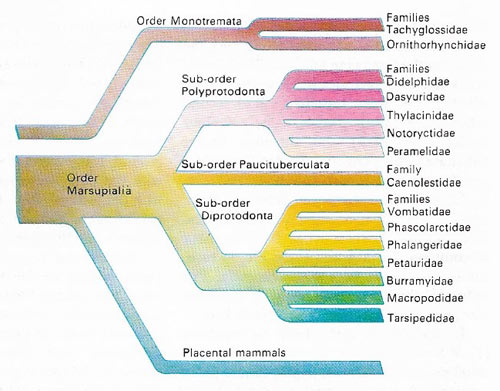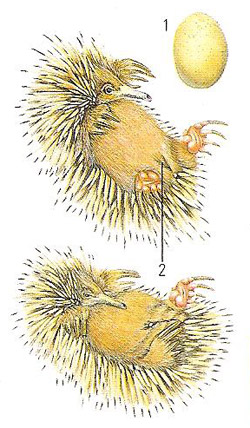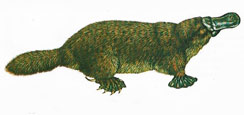Monotremata

Figure 1. Only two branches of the order Monotremata, the egg-laying mammals, exist today: the spiny anteaters of Australia and New Guinea and the Australian duck-billed platypus.

Figure 2. The echidna lays a tiny egg (1) that is soft-shelled and resembles a reptile's egg. Once the egg is laid, the echidna uses its hind limbs to roll it to a special incubation groove (2). The minute hatchling is about 1.25 centimeter (0.5 inch) long.
The Monotremata are a subclass of mammals, living members of which are restricted to five species – four species of echidna (spiny anteater) (Tachyglossus sp) and the duck-billed platypus (Ornithorhinchus sp), all found only in Australia and New Guinea (Figure 1). Monotremes differ from all other mammals in not bearing live young because, like reptiles, they lay eggs with soft leathery shells. The eggs are temporarily transferred to a pouch beneath the female's abdomen where they hatch and are nourished by rudimentary mammary glands. The Monotremata and the marsupials are the two most primitive orders of mammals. Whereas monotremes lay eggs, marsupials, such as the kangaroo, have pouches to house and protect their young, which are born in embryonic form.
Monotremes have highly modified snouts or beaks, and modern adult monotremes have no teeth but the platypus has a horny ridge which is used to demolish the shells of mollusks. Like other mammals, however, monotremes have a single bone in their lower jaw, three middle ear bones, high metabolic rates, and hair, and they produce milk to nourish the young.
Although the monotremes have fur that evolved to help maintain body temperature, the temperature-regulating mechanism in the brain is imperfect; as a result they tend to be cooler and have a more variable body temperature than higher mammals.
Both kinds of monotremes have, however, developed marked specializations peculiar to their different ways of life. The platypus has webbed feet as well as its duck-like bill to equip it for an aquatic existence. The echidna has long claws and a pointed nose for digging ants out of their nests.
 |
| The duck-billed platypus uses its distinctive bill to paddle for the mollusks, chiefly mussels and snails, on which it feeds, It lives by the water, building tortuous burrows in the river banks where it nests. The female remains in the nest (which may be lined with gum leaves) until the young hatch, a process that takes about two weeks. The platypus usually lays two eggs at a time which are 1.6–1.8 centimeters (0.5 inch) in length and 1.4–1.5 centimeters in diameter.
|
 |
| The echidna, or long-nosed spiny anteater, is a monotreme of the family Tachyglossidae. It can grow from 45 to 77 centimeters (1.5 to 2.5 feet) in length. The order contains one other family (Ornithorhynchidae).
|


